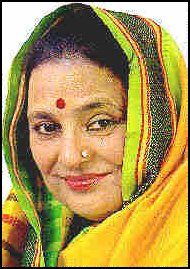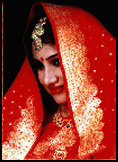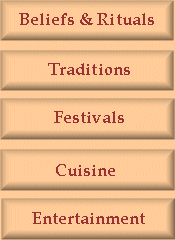


Traditions and customs are the most important factors among the people of every religion and ethnicity.Bengali traditions are very unique and quite different from those of other states in India.
The Bengali people are perhaps the greatest food lovers in the Indian subcontinent. A leisurely meal of many items which requires long hours of labor and ingenuity in the kitchen has
long been a major part of Bengali culture. The traditional way of serving food is on the floor, where individual pieces of carpet, called asans, are spread for each person to sit on.In front of this seat is placed a large platter made of bell metal/steel or on a large piece of fresh cut banana leaf.
Around this platter a number of small metal or earthen bowls are arrayed in which portions of dal, vegetables, fish, meat chutney and dessert are served. In the center of the platter sits a small mound of piping hot rice flanked by vegetable fritters, wedges of lime, whole green chilies and perhaps a bit of pickle. Finally in the center of the mound a little hole is made to pour in a spoonful of ghee to flavor the initial mouthfuls of rice.
Its a great pleasure to be present in a Bengali "biye-baari"(wedding), which takes place in an extremely traditional way. The marriage normally does not take place between close blood relatives and persons having the same gotras. Also there are few months when the Bengalis don't have their wedding. That is between middle of December to middle of January (Poush), middle of March to middle of April (Chaitra) and middle of August to middle of September(Bhaadra).
The marriage is conducted only in the evening, in the presence of a priest, at the house of normally the bride. On the wedding day,the ceremonies, ‘Dodhi Mangal’ and ‘Gaaye halud’ (turmeric bath) will be held in both the houses on the wedding day, very early in the morning, before sunrise. The place where the wedding takes place is fully decorated with attractive patterns(alpona) made out of rice paste with water.
Small banana trees are placed at the entrance of the house. Under the tree, a mangal ghot (usually a small, copper pitcher-shaped vessel) is placed. In the ghot, a mango stem with five leaves (amra pallab) is placed in water. This tree and the ghot are kept for ten days after the wedding. On the side of the ghot, a Sri (star sign) symbol is drawn with sindoor mixed in oil. The door of the entrance is decorated with a string of mango leaves, which stays for a period of one year after marriage.
The Priest comes readily with an idol of Bhagwan Narayan. The would-be couple have to take oath in the name of ‘Narayan’. Paternal uncle of both the families performs ‘Vridhi’. The bride wears Banarasi sari and the groom wears Dhoti and Kurta. When the bridegroom's procession reaches the bride's place, they are welcomed by blowing conch shells, ringing bells and ululation. Exchange of garlands take place between the couple and they are kept awake in the night.
The next morning, ‘Sun God’ is worshipped in the presence of the Priest. During the departure(bidaai) ceremony the couples wear their wedding clothes. The moment, both of them arrive at the groom’s house, the women pour water on the ground under the vehicle, before they alight. Then a flat metal plate containing a mixture of lac dye(alta) and milk is brought out by the elder woman of the house. The elder brother’s wife holds the plate under the bride’s feet, and the latter imprints her soles on the mixture of lac and milk.
The groom then takes brides into his house and presents Ornaments and Sarees and then slips an iron bangle on to his wife’s left arm, amidst conch shells and ring bells. The bride does not eat any food in her in-law’s house till the Bou Bhat. In the morning after the wedding ceremony, the bride who wears a new sari, is served lunch on a new plate. In the same evening, a reception is thrown by the groom’s father.
At night, the newly wed couple’s room will be decorated with flowers with bride wearing a new sari and the groom a dhoti and kurta. The flowers and clothes for this ceremony(Phool Sajja) come from the bride’s house, apart from sweets. A couple of days after the marriage, in bride’s house, the thread which has been tied on her wrist by the priest during the wedding is cut. The colourful ceremony ends happily after the flower decoration.
